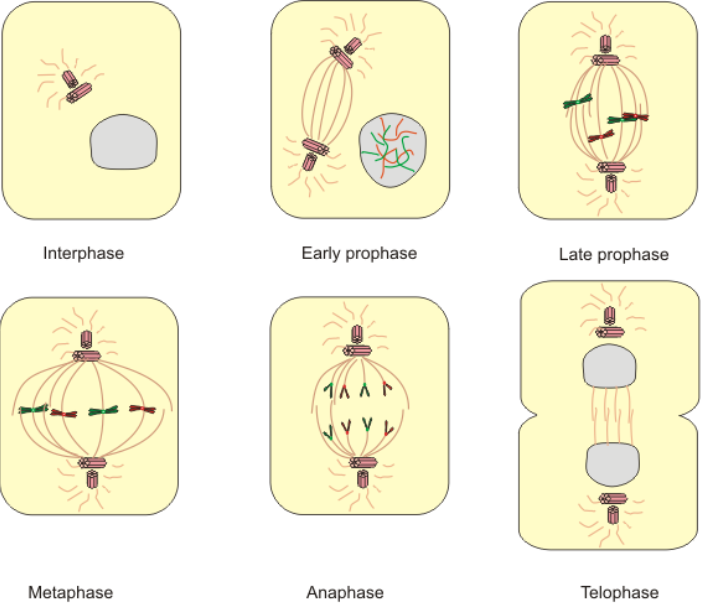
Explain mitosis with a neat labelled diagram.
Answer
551.4k+ views
Hint: Mitosis is the process of cell division involved in the somatic cells. The mother cell divides to produce two daughter cells which are genetically identical. It is important for growth, repair and development of the cells. The cells split into two with equal numbers of chromosomes.
Complete Answer:
Prior to the mitotic division, the cell undergoes interphase. In this stage the cell does not show any physical change. The DNA gets replicated during this stage.
The mitosis is mainly comprises of four stages-
1. Prophase - It is the longest stage of the mitosis.In this stage the chromosomes become short and distinct. The chromatids are held by the centromere. The nucleolus and nuclear membrane disappear.
2. Metaphase - In this stage the spindle fibres are formed and the chromosomes arrange themselves at the equatorial plate attached to the spindle.
3. Anaphase - The chromatids get separated at the centromere and the chromosomes start moving towards the pole. The chromatids turn into chromosomes.
4. Telophase - The chromosomes reach at the poles and the spindle fibres begin to disappear. The nucleolus is formed at each pole and the nuclear membrane starts appearing.
After telophase, cytokinesis starts which is the division of the cytoplasm. The cytoplasm divides as the plasma membrane starts constricting at the equator. This forms two daughter cells.

Note: The significance of mitosis are-
- The new plant parts are formed as a result of mitosis.
- Mitosis is the mode of asexual reproduction in some organisms.
- Mitosis does not involve crossing over. So the daughter cells formed are exactly identical.
Complete Answer:
Prior to the mitotic division, the cell undergoes interphase. In this stage the cell does not show any physical change. The DNA gets replicated during this stage.
The mitosis is mainly comprises of four stages-
1. Prophase - It is the longest stage of the mitosis.In this stage the chromosomes become short and distinct. The chromatids are held by the centromere. The nucleolus and nuclear membrane disappear.
2. Metaphase - In this stage the spindle fibres are formed and the chromosomes arrange themselves at the equatorial plate attached to the spindle.
3. Anaphase - The chromatids get separated at the centromere and the chromosomes start moving towards the pole. The chromatids turn into chromosomes.
4. Telophase - The chromosomes reach at the poles and the spindle fibres begin to disappear. The nucleolus is formed at each pole and the nuclear membrane starts appearing.
After telophase, cytokinesis starts which is the division of the cytoplasm. The cytoplasm divides as the plasma membrane starts constricting at the equator. This forms two daughter cells.

Note: The significance of mitosis are-
- The new plant parts are formed as a result of mitosis.
- Mitosis is the mode of asexual reproduction in some organisms.
- Mitosis does not involve crossing over. So the daughter cells formed are exactly identical.
Recently Updated Pages
Master Class 10 General Knowledge: Engaging Questions & Answers for Success

Master Class 10 Science: Engaging Questions & Answers for Success

Master Class 10 Social Science: Engaging Questions & Answers for Success

Master Class 10 Maths: Engaging Questions & Answers for Success

Master Class 10 English: Engaging Questions & Answers for Success

Master Class 10 Computer Science: Engaging Questions & Answers for Success

Trending doubts
The shortest day of the year in India

Why is there a time difference of about 5 hours between class 10 social science CBSE

Write a letter to the principal requesting him to grant class 10 english CBSE

What is the median of the first 10 natural numbers class 10 maths CBSE

The Equation xxx + 2 is Satisfied when x is Equal to Class 10 Maths

State and prove converse of BPT Basic Proportionality class 10 maths CBSE




